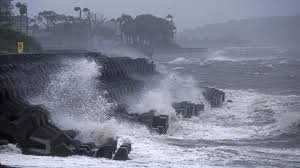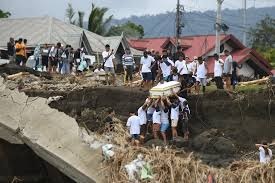Introduction: A Nation in Perpetual Peril

The Republic of the Philippines, an archipelago nation situated along the Pacific “Ring of Fire” and within the typhoon belt, is once again confronting the profound threat posed by nature’s fury. As of this weekend, Tropical Storm Fengshen is making its calculated and dangerous approach, forcing the evacuation of thousands of residents along the vulnerable Pacific coast. This event, however, is not an isolated incident; it is the latest chapter in a cyclical narrative of environmental volatility. Annually, the country endures the battering of approximately 20 tropical cyclones, a grim regularity that disproportionately impacts disaster-prone, impoverished communities where millions struggle for sustenance and stability.
The immediate focus is on the eastern seaboard, particularly Catanduanes, a relatively isolated and economically disadvantaged island with a population of about 270,000. As weather experts issue stark warnings of potential coastal inundation and landslides, the local government has initiated the familiar and often desperate drill of mass evacuation.
Fengshen’s Imminent Threat and Coastal Vulnerability
Tropical Storm Fengshen, internationally recognized by its local name Ramil (as suggested by concurrent data), is projected to sweep past the vicinity of Catanduanes later on Saturday. Forecasts indicate the storm carries maximum sustained winds near the center of $65 \text{ km/h } (40 \text{ mph})$, with gusts climbing to $80 \text{ km/h } (50 \text{ mph})$. While not yet a super typhoon, its true danger lies not just in its wind speed, but in the accompanying hydrological threats.
The government weather service, the Philippine Atmospheric, Geophysical and Astronomical Services Administration (PAGASA), has explicitly warned that Fengshen will unleash torrents of rain alongside a “minimal to moderate risk” of coastal flooding. This flooding is anticipated to be exacerbated by storm surges capable of pushing waves of up to $1.2 \text{ meters } (3.2 \text{ feet})$ inland, a height sufficient to swamp low-lying coastal villages.
In response, provincial disaster management officials confirmed that more than 9,000 residents across Catanduanes have been moved to established evacuation centres. This pre-emptive action is the result of harsh, repeated lessons. Catanduanes is strategically, and unfortunately, positioned as the Philippines’ first major landmass to encounter the majority of cyclones that brew over the western Pacific Ocean.
Gerry Rubio, a rescue official, conveyed the urgency of the provincial government’s directive to the AFP news agency, emphasizing the need for local authorities to “activate their respective evacuation plans.” These mandatory plans target residents in “high-risk areas,” encompassing not only the immediate coastlines and low-lying plains but also inland communities susceptible to deadly flash floods and landslides.
The Broader Context: A Flurry of Recent Calamities
Fengshen’s approach is particularly taxing as it finds the nation in a state of extended recovery from a relentless succession of other powerful natural disasters that struck in recent weeks and months. The sheer concentration of catastrophic events highlights the country’s extreme vulnerability.
In late September, the northern regions of the country were devastated by Super Typhoon Ragasa (locally named Nando).1 As one of the most powerful storms of the year, Ragasa made landfall in the northern Philippines, bringing catastrophic winds and widespread flooding that forced the evacuation of thousands of residents and resulted in multiple fatalities.2 The sight of flooded rice fields in towns like Camalaniugan, Cagayan province—captured in harrowing aerial images—served as a stark reminder of the immense cost borne by the agricultural heartlands.
Adding to the meteorological turmoil, the Philippines has simultaneously wrestled with severe seismic activity. Earlier this month, the central province of Cebu was rocked by a destructive magnitude $6.9$ earthquake, claiming the lives of at least 79 individuals in its wake. Days later, the southern Philippines was subjected to a powerful magnitude $7.4$ earthquake off its coast, which triggered a secondary, but still severe, magnitude $6.9$ quake. These seismic events collectively resulted in several additional deaths and necessitated the issuance of tsunami warnings, terrifying communities already on edge.
Climate Change: Exacerbating the Crisis

The increasing intensity and clustering of these major weather systems are not merely random events; they align with alarming global trends attributed to climate change. Scientists worldwide have consistently warned that as the planet warms due to human-driven greenhouse gas emissions, tropical cyclones are becoming more powerful, carrying greater moisture, and delivering more destructive rainfall.
For the Philippines, this means that the annual average of 20 storms and typhoons is now characterized by greater volatility and higher threat levels. The most vulnerable populations—millions of impoverished Filipinos who reside in flimsy coastal shanties, riverbanks, or steep, deforested slopes—bear the brunt of this climate vulnerability. Their precarious living conditions offer minimal protection against high winds, storm surges, or the landslides triggered by torrential rains. The recurring cycle of disaster, death, and displacement traps these communities in perpetual poverty, making recovery a Herculean task that is often interrupted by the next incoming storm.
Disaster Preparedness and the Road Ahead
The swift, organized evacuation response in Catanduanes underscores a hard-won, ingrained culture of disaster preparedness unique to the Philippines. Yet, the nation’s constant battle against the elements necessitates more than just rapid reaction. It demands long-term, systemic solutions:
-
Investment in Climate-Resilient Infrastructure: Upgrading critical infrastructure, including sturdier public buildings for evacuation, reinforced seawalls, and improved drainage systems, particularly in high-risk zones.
Poverty Alleviation and Relocation: Addressing the root vulnerability by providing safe, sustainable housing and livelihood alternatives for millions currently living in danger zones.
Enhanced Early Warning Systems: Continuously improving the accuracy and dissemination speed of meteorological and seismic warnings to ensure every citizen has adequate time to prepare and evacuate.
As Tropical Storm Fengshen tracks its path across the Philippine Sea, the nation watches with bated breath. The resilience of the Filipino people is undeniable, forged by generations of weathering nature’s worst. However, without substantial global and domestic investment in climate adaptation and poverty reduction, the current pattern—a devastating sequence of typhoons, earthquakes, and deadly floods—will continue to define the future of this beautiful yet perpetually imperiled archipelago.




